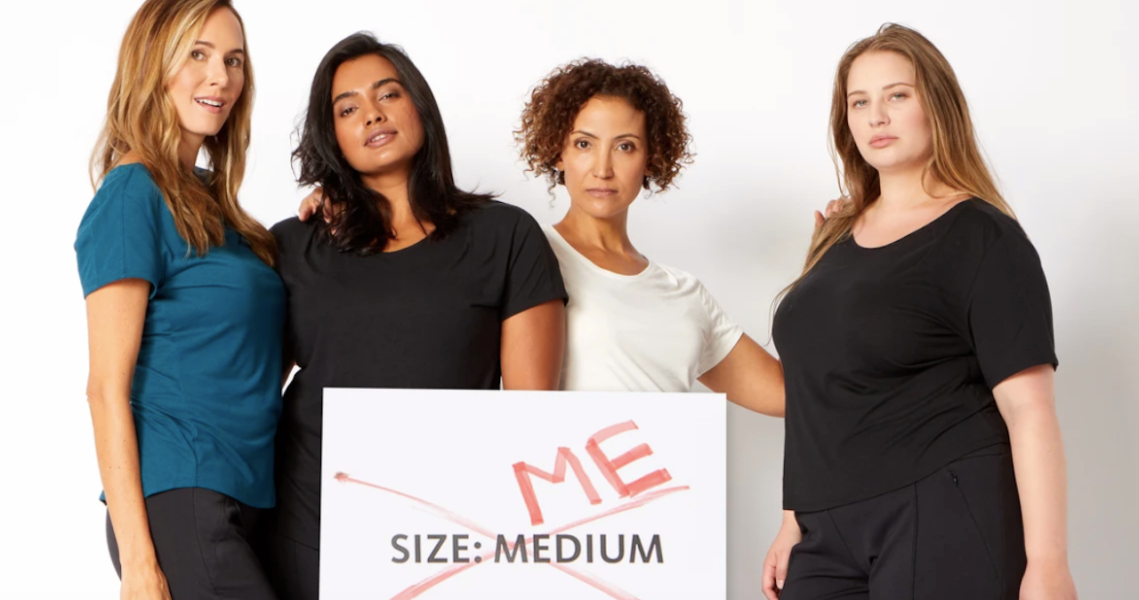Fashion brands including Universal Standard, RedThread and Unspun are calling for a size-free industry. Their basis: The current size scale is discriminatory and forces women to fit into a box that, often, wasn’t made for them.
“The current system is broken; sizing makes no sense,” said Beth Esponnette, co-founder of denim brand Unspun, which is launching a body scan customization tool via an app next month. “Brands are always trying to reach the maximum number of people, and so they’re catering to the dominant group, and marginalized people are being ignored.”
Esponnette said, based on her studies of anthropometrics, different races skew toward different proportions. However, she called out, women’s sizing in the U.S. is based exclusively on white women’s bodies: The sizes, derived from the body measurements of 15,000 women, were first defined in a report titled “Women’s Measurements for Garment and Pattern Construction,” published by the USDA in 1941.
For fashion companies, restricting sizes to those suited to the majority of shoppers is common, and is a matter of cutting corners and cutting costs. Brands have also been known to base their sizes on the consumer they want to be associated with, evident in luxury brands’ notorious history of distancing themselves from the plus-size market.
Alexandra Waldman, co-founder and creative director of Universal Standard, which makes apparel in sizes 00-40, said much of the problem lies in brands’ reliance on grading measurements up and down to establish their sizes. Modern fashion companies fine-tune the size scale for their brand, based on how their clothing drapes on fit models — who often look like models. They perfect one or two sizes, and go from there.
“Using a mathematical formula is a very fast and established way of doing it, but it’s also very careless,” said Waldman. “The [resulting sizes] actually suit a very small number of people.”
“A lot of brands sacrifice real and true value, based on very old and unsupportable ideas of aesthetics,” said Waldman, in regard to brands’ go-to process of fitting pieces on two professional models, versus a range of “real” women. Universal Standard fits each of its designs to women of each size it sells. “Beauty is not as narrow as we’ve been led to believe, and once you once you understand that, it opens the door to so much more diversity and excellence in design.”
Ad position: web_incontent_pos1
Waldman said agencies’ fit model rosters are slowly becoming more diverse, and it’s up to designers and brands to get it up to par. As the demand rises, so will the supply, she said.
Monique Morin, a designer who consults for brands and has a 3-year-old namesake lingerie company, said using a diverse array of fit models is expensive, which is a “risk” for a young brand: Agencies charge $300 per hour, and typically, only two pieces can be fitted in an hour. But it’s worth it, as getting the size right fuels customer loyalty and minimizes returns. Her return rate is “basically zero,” she said. She works with a diverse lineup of models in six sizes, and she’s working toward adding “curvy” options to each size to broaden the potential customer base.
For women, shopping clothes is often a compromise of choosing the best fit, rather than the perfect. And all founders interviewed for this story said women feel flawed if they can’t find a size that works for their body; they see it as a personal issue versus an industry issue.
Megan Litchfield, CEO and co-founder of 18-month-old custom fashion brand RedThread, said her company’s survey of hundreds of women found that 90% could not find pants that fit them off the rack. RedThread’s sales have doubled or tripled every month since launch, she said, and its return rate is less than 5%.
According to Litchfield, custom, on-demand fashion is the solution to the sizing problem and the future of the industry. The one-time barriers to wearing custom-fit clothing — namely, that the measuring process is complicated, the process is time-consuming and it’s expensive — are being eliminated. (RedThread pants are $128 and ship in 1-2 weeks.) She expects that, as more custom brands come to market, more people will demand their level of sustainability and the fit they offer. Eventually, everyone will have their measurements on their smartphone Wallet, for easy access when placing custom orders, she said.
Ad position: web_incontent_pos2
“Until now, there’s been an overproduction of these sizes,” she said. “It’s not helping the world, and it’s not helping women.”
Esponnette said Unspun’s plan is to become a platform, offering its scanning technology to more brands. It’s already working with H&M on a custom denim launch for its Weekday brand, scheduled for September.
For brands not yet ready to tackle custom, Esponnette recommended digitizing the fit process, a practice that’s been catching on in recent years. “They can work with hundreds of models in a database and make adjustments from there,” she said. “There’s no reason to base a size range on a couple models.”


